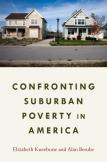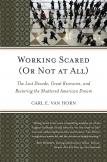What Recovery?
Written at the height of American affluence half a century ago, the singular sociological insight of Michael Harrington’s The Other America still rings true: “The other America, the America of poverty, is hidden today in a way that it never was before. Its millions are socially invisible to the rest of us.” This is something that anyone who has lived in the third world notices right away about the United States: there are no favelas in Manhattan.
Two books from scholars in two think tanks not only remind us that the invisible poor and unemployed we have always with us; they tell us to look for them in an unexpected locale, living in despondency in a land known for its quintessential optimism.
Forget the inner city; poverty has moved to the suburbs like everyone else, write Elizabeth Kneebone and Alan Berube of The Brookings Institution in Confronting Suburban Poverty in America. In the past decade, their number-crunching shows, the poor population of the suburbs shot up 64 percent (compared with 29 percent in cities). Yet what is left of the antipoverty policies of the last 50 years (in wonkspeak, “place-based programs to fight poverty”) was designed with the urban ghetto in mind.
Drawing on surveys and interviews with some 25,000 workers from 1998 through the recent recession and fledgling recovery, Carl Van Horn, who heads the John J. Heldrich Center for Workforce Development at Rutgers University, paints a picture of widespread personal discouragement and depression in Working Scared (Or Not at All). Worse, Van Horn adds, the very federal programs designed to help were cut 14 percent even before the financial meltdown of 2008; the stimulus package is long gone; and before us are seemingly endless cuts by a Congress running on autopilot.
Back in the early 1960s, Harrington’s book set off an American moral self-search that effectively launched the War on Poverty two years later. Both current works offer new policy prescriptions, even if poverty is not a foreseeable issue in the coming congressional elections.
What is needed, say the Brookings scholars, is a set of incentives and leverage grants jointly run by the Departments of Education, Health and Human Services, Housing and Urban Development and Labor, which operate more than 80 relevant programs. They want to see interdisciplinary cooperatives that are based locally and draw funding from a potpourri of federal and philanthropic sources.
Van Horn is more ambitious. He argues for a new policy designed to “educate, train, and retrain people so that they can achieve their full potential and offer employers valued skills.” He pleads for a “more aggressive pro-growth policy” that avoids “zero-sum politics” by seeking to enlarge the economic pie rather than fight over shrinking slices.
His program consists of four “national priorities,” as follows:
• Reformed education: prepare all students for college and the workplace;
• “Reemployment insurance”: replace unemployment insurance, focused on early help for the unemployed;
• A “renewed worker-employer compact” to bolster confidence in the fairness of the free market; and
• Expanded layoff warning requirements, family-friendly leave and flextime.
The Brookings scholars’ central finding is very simple: until 2000 poverty in the suburbs tracked somewhat below the overall rate. Then it began to soar, and by 2011 some 16.4 million poor people resided in jurisdictions outside central cities, more than three million more than in cities. The suburban poverty rate was 16.4 percent in 2011, while the city counterpart was 13.4 percent.
This is unusual. In 2000, those same rates were 10 percent and 10.4 percent, respectively. Since 1970 the suburban poverty rate had remained about one full percentage point, or more, below the city rate.
At a briefing on the work, Kneebone said the change is partly the result of low-income people moving to the suburbs, but also a “slipping” suburban standard of living.
During this century’s first decade, regional economies declined in the Midwest and Northeast, and the housing market collapsed (especially in the Sun Belt). Meanwhile, jobs began to fan out to what reporter Joel Garreau in 1992 presciently dubbed “edge cities.” But the new jobs paid less than middle-class jobs and drew poorer people out, so they could live closer to work.
The suburbs, which had been havens for whites of European origin who were fleeing urban desegregation, experienced population growth that outpaced cities. Although the suburbs began to diversify demographically, Kneebone and Berube point out that immigrants accounted for 30 percent of suburban population growth and only 17 percent of the growth in the number of poor people. Instead, the postwar housing stock aged and easy credit opened the floodgates to U.S.-born poor residents moving to suburbia.
Berube and Kneebone point as an example to an existing Chicago area “collaborative” founded in the face of the foreclosure crisis. Four leading low-income housing groups formed the Mortgage Resolution Fund to help homeowners stay in their homes, as well as to revitalize hard-hit communities. In that area M.R.F. negotiated with state and federal agencies and ended up purchasing 270 nonperforming mortgages. The effort has expanded to the cities of Akron, Canton, Cleveland and Youngstown in Ohio.
Regular surveys and interview by the Heldrich Center demonstrate that by the last quarter of 2011, only 7 percent of workers who lost jobs said they had “made it back” to where they were before the recession, and 23 percent are “coming back.” The remaining 70 percent described themselves as “downsized” (33 percent), “devastated” (21 percent) or “totally wrecked” (15 percent).
“I am not married. My parents have passed away. So I am quite scared of what will happen if I do not land a job within the next couple of months,” one worker told interviewers. Another said, “Nobody has called me in seven months. I don’t feel important. I’m not contributing to family finances.”
Van Horn argues persuasively that these individuals and their peers have been beggared by the four horsemen of the economic apocalypse: globalization and offshoring; mergers, acquisitions and restructuring; the shift from manufacturing to a knowledge or service economy; and deunionization.
This article also appeared in print, under the headline “What Recovery?,” in the March 3, 2014, issue.









